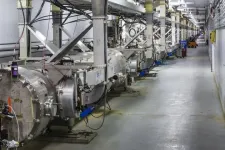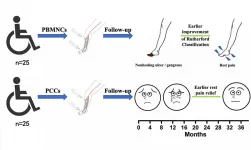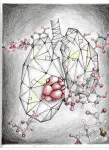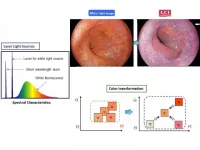(Press-News.org) Operators of the primary particle accelerator at the U.S. Department of Energy's Thomas Jefferson National Accelerator Facility are getting a new tool to help them quickly address issues that can prevent it from running smoothly. A new machine learning system has passed its first two-week test, correctly identifying glitchy accelerator components and the type of glitches they're experiencing in near-real-time.
An analysis of the results of the first field test of the custom-built machine learning system was recently published in Physical Review Accelerators and Beams.
The Continuous Electron Beam Accelerator Facility, a DOE User Facility, features a unique particle accelerator that nuclear physicists use to explore the heart of matter. CEBAF is powered by superconducting radiofrequency cavities, which are structures that enable CEBAF to impart energy to beams of electrons for experiments.
"The heart of the machine is these SRF cavities, and quite often, these will trip. When they trip, we'd like to know how to respond to those trips. The trick is understanding more about the trip: which cavity has tripped and what kind of fault it was," said Chris Tennant, a Jefferson Lab staff scientist in the Center for Advanced Studies of Accelerators.
Expert accelerator scientists review information on these faults and can use that to determine where the fault started and what type of fault it is, thus informing CEBAF operators on the best way to recover from the fault and mitigate future ones. However, that expert review takes time that operators don't have when experiments are underway.
In late 2019, Tennant and a team of CEBAF accelerator experts set out to build a machine learning system to perform that review in real-time.
They worked with several different groups to design and build from scratch a custom data acquisition system to pull information on cavity performance from a digital low-level RF system that is installed on the newest sections of particle accelerator in CEBAF, which includes about one-fifth of the SRF cavities in CEBAF. The low-level RF system constantly measures the field in SRF cavities and tweaks the signal for each one to ensure that they operate optimally.
When a cavity faults, the machine learning data acquisition system pulls 17 different signals for each cavity from the digital low-level RF system for analysis.
"We're leveraging information-rich data and turning it into actionable information," he said.
These same information-rich data are used by accelerator experts to help identify faulting cavities and causes. These past analyses were used to train the machine learning system prior to deployment.
The new system was installed and tested during CEBAF operations over an initial two-week period in early March 2020.
"For that two weeks, we had a few hundred faults that we were able to analyze, and we found that our machine learning models were accurate to 85% for which cavity faulted first and 78% in identifying the type of fault, so this is about as well as a single subject matter expert," Tennant explained.
This near-real-time feedback means that CEBAF operators can take immediate steps to mitigate problems that arise in the machine during experimental runs, and hopefully preventing smaller problems from turning into bigger ones that can reduce experiments' runtime.
"The idea is eventually, the subject matter experts won't need to spend all their time looking at the data themselves to identify faults," he said.
The next step for Tennant and his team is to analyze data from a second and longer test period that took place in late summer. If the system performed as well as the first test indicates, the team hopes to begin designs for extending the system to include older SRF cavities in CEBAF.
This project was originally proposed and funded through Jefferson Lab's Laboratory Directed Research & Development program for fiscal year 2020, and it was later selected by DOE for a $1.35 million grant to leverage machine learning to revolutionize experimentation and operations at user facilities in the coming years.
"This was a proof-of-principle project. It was somewhat riskier, because several years ago, when this project was proposed, none of us on the team knew anything about machine learning. We just sort of jumped in," Tennant said. "So, sometimes supporting those higher-risk/higher-reward projects really pays off."
INFORMATION:
Further Reading
Technical Paper: Superconducting radio-frequency cavity fault classification using machine learning at Jefferson Laboratory, Physical Review Accelerators and Beams: https://journals.aps.org/prab/abstract/10.1103/PhysRevAccelBeams.23.114601
DOE Funding Boosts Artificial Intelligence Research at Jefferson Lab: https://www.jlab.org/news/releases/doe-funding-boosts-artificial-intelligence-research-jefferson-lab
Improving Particle Accelerators with Machine Learning: https://www.jlab.org/news/stories/improving-particle-accelerators-machine-learning
The Butterfly in the Machine: https://www.jlab.org/news/ontarget/target-september-2012#butterfly
Jefferson Science Associates, LLC, a joint venture of the Southeastern Universities Research Association, Inc. and PAE, manages and operates the Thomas Jefferson National Accelerator Facility, or Jefferson Lab, for the U.S. Department of Energy's Office of Science.
DOE's Office of Science is the single largest supporter of basic research in the physical sciences in the United States and is working to address some of the most pressing challenges of our time. For more information, visit https://energy.gov/science.
Microorganisms are the most abundant and diverse form of life on Earth. However, the vast majority of them remain unknown. Indeed, only a small fraction of the microorganisms of our planet can be cultured under traditional conditions, leaving a world of unculturable organisms out of our scope. This is especially true for bacteria thriving under extreme conditions as the harsh conditions are hardly reproducible in a lab. While some microbial studies have been performed in the Sahara, the Atacama, and the Gibson desert, European arid lands remain poorly studied.
To finally explore the microbial community of some European deserts, researchers ...
An effective response to a pandemic like the COVID-19 will only be successful if people voluntarily follow the rules and guidelines of decision-makers and experts. Many of the required measures, such as avoiding social contact and significantly changing our daily habits require a strong commitment. Other necessary actions, such as regular hand washing, are often impossible to monitor and enforce. Adherence to the guidelines thus depends on people's personal commitment.
The ability of policy makers and experts to communicate convincingly to citizens has a strong influence on whether ...
CORVALLIS, Ore. - Co-developing land for both solar photovoltaic power and agriculture could provide 20% of total electricity generation in the United States with an investment of less than 1% of the annual U.S. budget, a new paper by Oregon State University researchers found.
Wide-scale installation of agrivoltaic systems could lead to an annual reduction of 330,000 tons of carbon dioxide emissions in the U.S - the equivalent of 75,000 cars off the road per year - and the creation of more than 100,000 jobs in rural communities, while minimally impacting crop yield, the researchers say.
"Agrivoltaics provide a rare chance for true synergy: more food, more energy, lower water demand, lower carbon emissions, and more prosperous rural communities," said Chad Higgins, an associate ...
Durham, NC - Mid-term results of the first clinical trial designed specifically to evaluate the safety and effectiveness of two cell therapies that are showing early promise in treating angiitis-induced critical limb ischemia were released today in STEM CELLS Translational Medicine. The study, by researchers at Zhongshan Hospital/Fudan University in Shanghai, compared how transplantation of peripheral blood mononuclear cells fared versus transplantation of purified CD34+ cells in treating this condition.
It revealed both therapies yielded satisfactory results and provided evidence for ...
DALLAS - Jan. 5, 2021 - Researchers at the Children's Medical Center Research Institute at UT Southwestern (CRI) have discovered a new metabolic vulnerability in a highly aggressive form of non-small cell lung cancer (NSCLC). These findings could pave the way for new treatments for patients with mutations in two key genes - KRAS and LKB1. Patients whose tumors contain both of these mutations, known as KL tumors, have poor outcomes and usually do not respond to immunotherapy.
"We used to think that most tumors rely on the same handful of metabolic pathways to grow, but we've learned over the last decade that this is an oversimplification. Instead, different tumor subclasses have particular metabolic needs arising from mutations ...
Trio of articles suggest that a single dose of vaccine, even if less effective than two doses, may have greater population benefit.
Three articles published today in Annals of Internal Medicine discuss the most effective vaccination strategy for maximum impact against the COVID-19 pandemic. The articles are accompanied by an editorial from Thomas J. Bollyky, JD, Director of Global Health Program, Council on Foreign Relations. Mr. Bollyky can be reached through Lauran Potter at lpotter@cfr.org. The full text of his editorial is available here: https://www.acpjournals.org/doi/10.7326/M20-8280.
Speed Versus Efficacy: Quantifying Potential Tradeoffs in COVID-19 Vaccine Deployment https://www.acpjournals.org/doi/10.7326/M20-7866.
Researchers from Yale School of Public ...
The combination of ibrutinib plus rituximab is approved for the treatment of adults with previously untreated chronic lymphocytic leukaemia (CLL). In an early benefit assessment, the German Institute for Quality and Efficiency in Health Care (IQWiG) now examined which advantages and disadvantages this drug combination has for the patients. For patients who could also be treated with the chemo-immunotherapy FCR, the assessment found an indication of a major added benefit in comparison with this appropriate comparator therapy. No study data are available for patients for whom FCR or other chemo-immunotherapy is not an option due to their poorer general health. An added benefit is therefore ...
PULLMAN, Wash. - In what may be a sign of climate-change-induced conflict, researchers have captured rare photographic evidence of a jaguar killing another predatory wild cat at an isolated waterhole in Guatemala.
In the footage, a male jaguar arrives near the waterhole and apparently lies in wait for an hour. It lets a potentially dangerous prey animal, a large tapir, pass by, but when the ocelot stops to drink, the jaguar pounces and carries off the smaller predator.
The event, detailed in a recent study published in the journal Biotropica, was captured in the Maya Biosphere Reserve in March 2019, a dry month in a drought year for the tropical forest, by wildlife ecologists from Washington State University ...
LA JOLLA--(January 5, 2021) Lithium is considered the gold standard for treating bipolar disorder (BD), but nearly 70 percent of people with BD don't respond to it. This leaves them at risk for debilitating, potentially life-threatening mood swings. Researchers at the Salk Institute have found that the culprit may lie in gene activity--or lack of it.
A new study led by Salk Professor and President Rusty Gage, which published in the journal Molecular Psychiatry on January 4, 2021, shows that decreased activation of a gene called LEF1 disrupts ordinary ...
Researchers from Tokyo Medical and Dental University (TMDU) describe an endoscopic modality for detecting upper gastrointestinal tract neoplasms by Linked Color Imaging that innovatively mixes light of different wavelengths to better depict mucosal changes
Tokyo, Japan - Recently there have been significant advances on several fronts in the ongoing war against cancer of the alimentary tract. Now, Japanese researchers report the development of another weapon: Linked Color Imaging (LCI), a novel endoscopic technique that improves detection of cancer by viewing the upper digestive tract mucosa under illumination that combines specific wavelengths of light to intensify subtle color variations indicative of neoplastic change.
Upper gastrointestinal (GI) endoscopy ...





